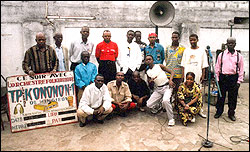The street was finding its own use for things long before William Gibson made his oft-quoted observation in 1987’s Count Zero. Take the likembé. Like cousins mbira (Zimbabwe, South Africa) and ikembé (Rwanda), the Congolese lamellaphone consists of a dozen or so keys attached to a resonator. You play the instrument by cradling it in both hands and plucking the keys with your thumbs—hence the clumsy Western appellation “thumb piano.” It’s an ancient piece of work, long in use when the first European explorers penetrated Africa. But whitey’s colonizing presence changed the instrument family’s sound significantly, after visionary players figured out that keys—originally bamboo—could be fashioned from the discarded spoons and bicycle spokes already littering the continent, producing a brighter, louder ping.
By the time Mawangu Mingendi founded Konono No. 1 in the late ’70s, Kinsasha’s population had swollen to more than 6 million, making his hometown and the Democratic Republic of the Congo’s capital one of Africa’s largest cities—and the planet’s. Even a fist piano with titanium keys the size of baseball bats would have been drowned out by ambient street noise. Like Dylan, the likembé virtuoso and his bandmates boldly went electric, building pickups with magnets salvaged from junked cars and cobbling together amps, as well as a sound system that utilizes megaphones and runs on car batteries—not the world’s cleanest-sounding audio components.
Lucky for us, they learned to live with the distortion first perceived as an undesirable by-product. Congotronics (Crammed), the band’s second album, finds Mingendi’s makeshift rig roaring in all its unsanitized glory alongside those of fellow likembé hotshots Mawangu Makuntima and Dodika Kungu. Augmented by vocalists and a percussion section that employs kitchen and junkyard gear as well as snare, bass, hi-hat, and traditional Congolese instruments, the ensemble magnifies the vibe of traditional Bazombo trance music to the point where a club kid in Sioux Falls could dig it.
Opener “Lufuala Ndonga” even rides a housey pulse for much of its nine-plus minutes. The song starts instrumentally sparse, with intricately syncopated call-and-response vocals bouncing on heavily accented percussion and minimal likembé bubble and moan that swells and recedes in waves, finally spilling into the foreground along with drums as the singers reduce their contribution to a few well-placed unison shouts. There’s even a disco whistle!
Vocals and old-time dance music gestures notwithstanding, track and album skew more heavily toward techno—hardly surprising, given the genre’s Afrocentrically futurist origins. But unlike Derrick May, Juan Atkins, Kevin Saunderson, and the other Detroit-techno founders—middle-class black teens who turned to Europe and their city’s auto factories for inspiration—Konono’s interest in cars extends only to parts. For them, as with Dizzee Rascal’s “road,” the street is habitat—stage and dance floor, too. Plus, their structural gambit’s origins in ritual make for a flow more fluid than even the most thoroughly through-composed Western electronic dance music allows for, endearing the band to both jazz enthusiasts and experimenticos, who also like their Neubautenesque appropriation tactics and alchemical tendencies. The latter group includes Dutch avant-anarcho-punks the Ex, who “discovered” Konono No. 1 on an African tour and brought them back to Holland, where Lubuaku, the band’s fuzzed-out debut, was recorded live. Thanks to producer, Crammed Discs honcho, and No. 1 fan Vincent Kenis, who went to no end of trouble to track them down, Congotronics captures the band’s sophisticated lo-fi growl with preferable Mac-assisted clarity. (The album was tracked live and outdoors on a G4 PowerBook in Kinshasa and mixed on a G5 in Brussels.)
Considering historical circumstances, Kenis lucked out. Belgium and Belgians—particularly King Leopold II, who pretty much created the Congo Free State as personal fiefdom and cash cow, sucking it dry minus oversight between 1885 and 1908—have a long and ugly history of exploiting the DRC people and resources in a fashion far too barbarous to report in this publication. (Intrepid souls seeking a complete rundown could do far worse than a visit to Wikipedia.) Suffice it to say that, given outright genocide, de facto slavery, inhuman terror tactics, and the kind of forced Europeanization that gives the lie to theologian Lamin Sanneh’s laughable contention that Christianity is more respectful of conquered cultures than Islam (they’re about evenly shitty in that regard), we’re lucky, too. The indigenous belief system that fuels No. 1’s jubilant racket might easily have been wiped out, along with the band’s ancestors. Instead, while abundantly alive, they suffer a tenuous existence in one of the world’s most turbulent regions. But at least Mingendi’s brainchild has come to understand that far-flung fans appreciate Konono No. 1 for exactly what they are—give or take the occasional Fender amp and distortion pedal. Papa Legba knows, Count Zero‘s digital deities would love ’em.
Konono No. 1 play Consolidated Works (500 Boren Ave. N., 206-381-3218) at 8 p.m. and 10:30 p.m. Fri., Nov. 4. $20 Earshot members/$22. Part of Earshot Jazz Festival.








